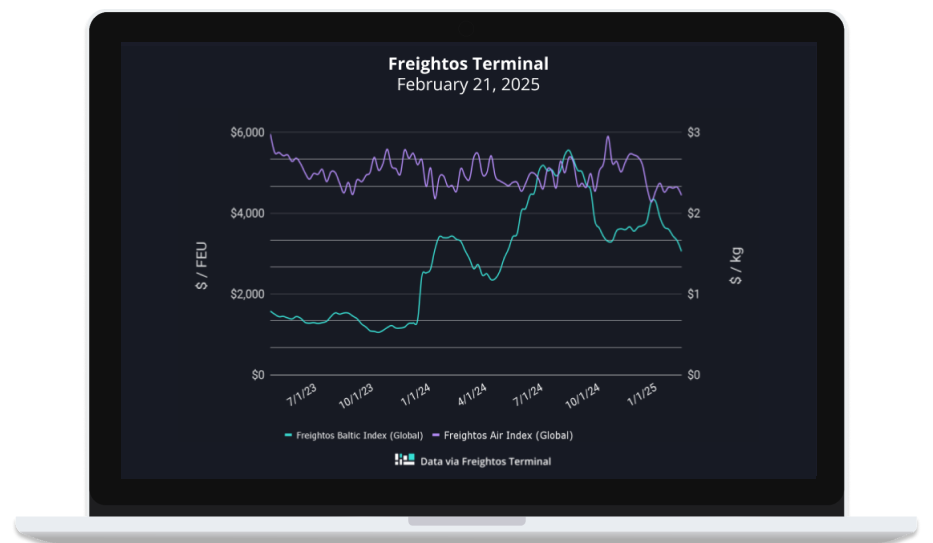Weekly highlights

- Asia-US West Coast prices (FBX01 Weekly) fell 8% to $4,362/FEU.
- Asia-US East Coast prices (FBX03 Weekly) fell 11% to $5,698/FEU.
- Asia-N. Europe prices (FBX11 Weekly) fell 7% to $2,954/FEU.
- Asia-Mediterranean prices (FBX13 Weekly) fell 7% to $4,129/FEU.
- China – N. America weekly prices increased 3% to $5.09/kg.
- China – N. Europe weekly prices increased 2% to $3.2/kg.
- N. Europe – N. America weekly prices stayed level at $2.35/kg.
Analysis
More proposed US policy changes unveiled last week are once again roiling international trade in general and ocean freight in particular. These steps included President Trump signing a memorandum advising federal agencies to research and take steps to prevent Chinese investment in certain US industries, including ports and shipping, and a commerce secretary proposal that all foreign vessels pay a US port tax.
But the biggest bombshell came from the US Trade Representative’s announcement of a proposed action that would target China’s growing influence in the shipbuilding industry by imposing fees ranging from $500k to $1.5 million per US port call by any Chinese carrier, Chinese vessel, or other carrier that has Chinese vessels as part of their global fleet. The action would also provide refunds to carriers using US vessels and sets targets for the share of US exports that should be moved by US flagged vessels in the coming years.
The actions are based on the findings of Biden-era USTR research into China’s shipbuilding industry which were released in mid-January. The report concludes that state-led efforts in China targeted the shipbuilding and logistics markets resulting in unfair advantages and harm to the US. China’s share of shipbuilding tonnage grew from less than 5% in 1999 to 50% in 2023, with 19% of the world fleet owned by China as of 2024.
About 20% of the more than 1,000 container vessels serving the US market are Chinese-made. But Chinese shipbuilders, according to Alphaliner data, accounted for the largest share of the nearly three million TEU of new containership capacity built in 2024 at 55%, with a similar share each year since 2021. Most carriers are therefore likely to have Chinese-made vessels somewhere in their global fleet and would be subject to these new fees.
Port call fees of $500k to $1.5 million would translate to about $100 to $300 per 40’ container for a 10k TEU vessel, with carriers likely to pass those additional costs on to shippers. But as the proposed action would apply these fees for each US port call and most long haul vessels make three US stops, the fee totals and the additional cost per container would be even higher.
The USTR announcement has triggered a comment period that will last until a March 24th public hearing. Following the hearing, the USTR will deliver recommendations to President Trump who will decide what actions to take.
Should this rule change take effect, some vessels may divert to Canada’s container hubs, though port capacity and the fact that routing through Canada is not feasible for all US destinations will probably limit this shift. Some carriers may also increase reliance on Mexico, though President Trump recently asked Mexico to increase tariffs on Chinese imports. This week he also announced that on March 4th he intends to implement the 25% tariffs on all Canadian and Mexican imports to the US that were postponed in early February. All of these steps would likely increase costs for US importers.
In the meantime, as Asia – Europe ocean trade enters its post-Lunar New Year lull container rates dipped below $3,000/FEU last week, about 50% lower than in early January and just below its seasonal low last year. Carriers are hoping to increase prices by about $1,000/FEU on March GRIs and blanked sailings, but sliding rates despite labor strikes and port congestion in Europe may reflect the impact of capacity growth and re-shuffled alliance competition to start the year.
Transpacific rates are falling post-LNY too, with daily rates so far this week at about $4,000/FEU to the West Coast and $5,000/FEU to the East Coast, for a 30% slide since January which includes reductions in some Peak Season Surcharges that have been in place for more than a year. Some of the current demand dip may be temporary and due to unavailable supply as factory production is still recovering post-holiday.
Container prices on these lanes are still about $1,000/FEU higher than a year ago, and elevated levels on these lanes in Q4 were largely attributable to shippers frontloading ahead of tariff increases. But the current rate slide may reflect that the intensity of this pull forward is easing as many shippers have already been building up inventories since November.
In air cargo, reports that the number of daily China – US freighter flights is dropping may point to a decrease in e-commerce volumes as the market prepares for a change to US de minimis rules. Nonetheless, air cargo spot rates remain elevated for now at about $5.00/kg and are even with levels a year ago.
Join 50k+ subscribers who get our free freight weekly update
“*” indicates required fields

